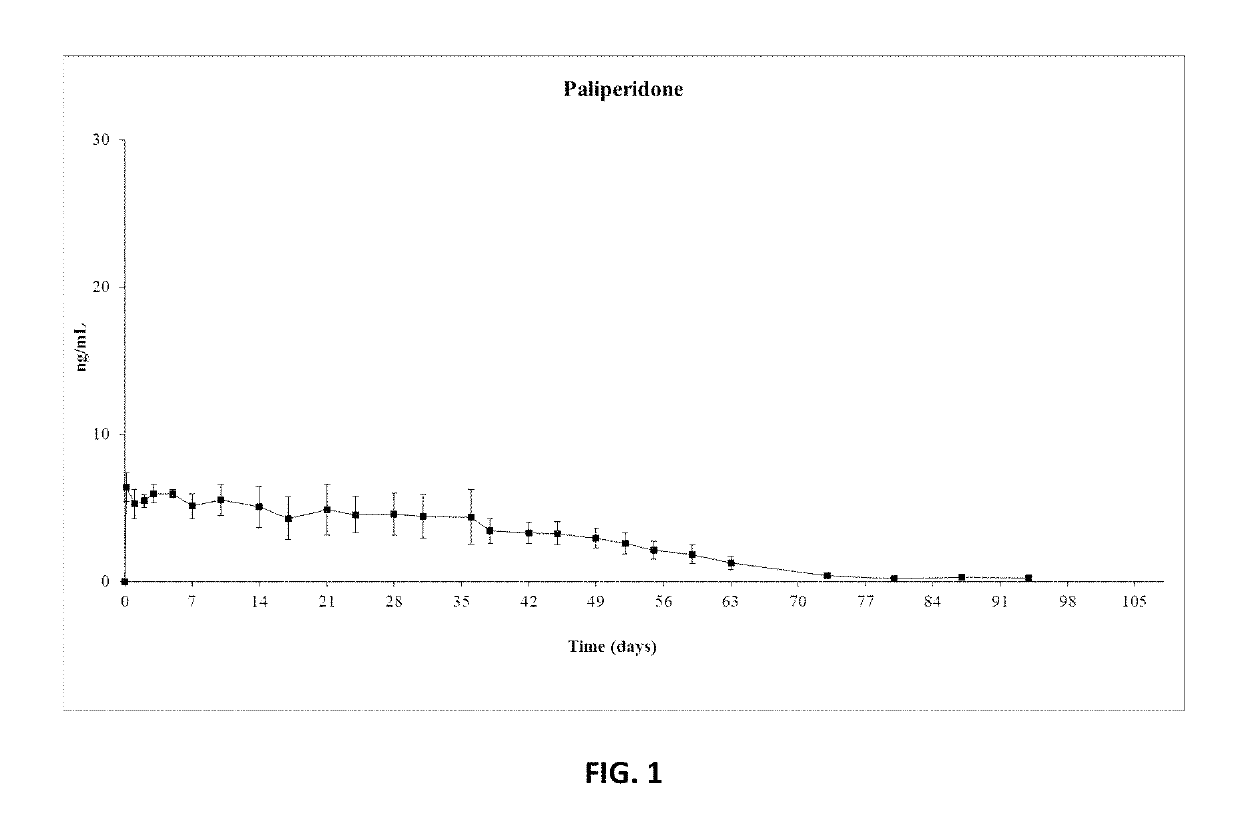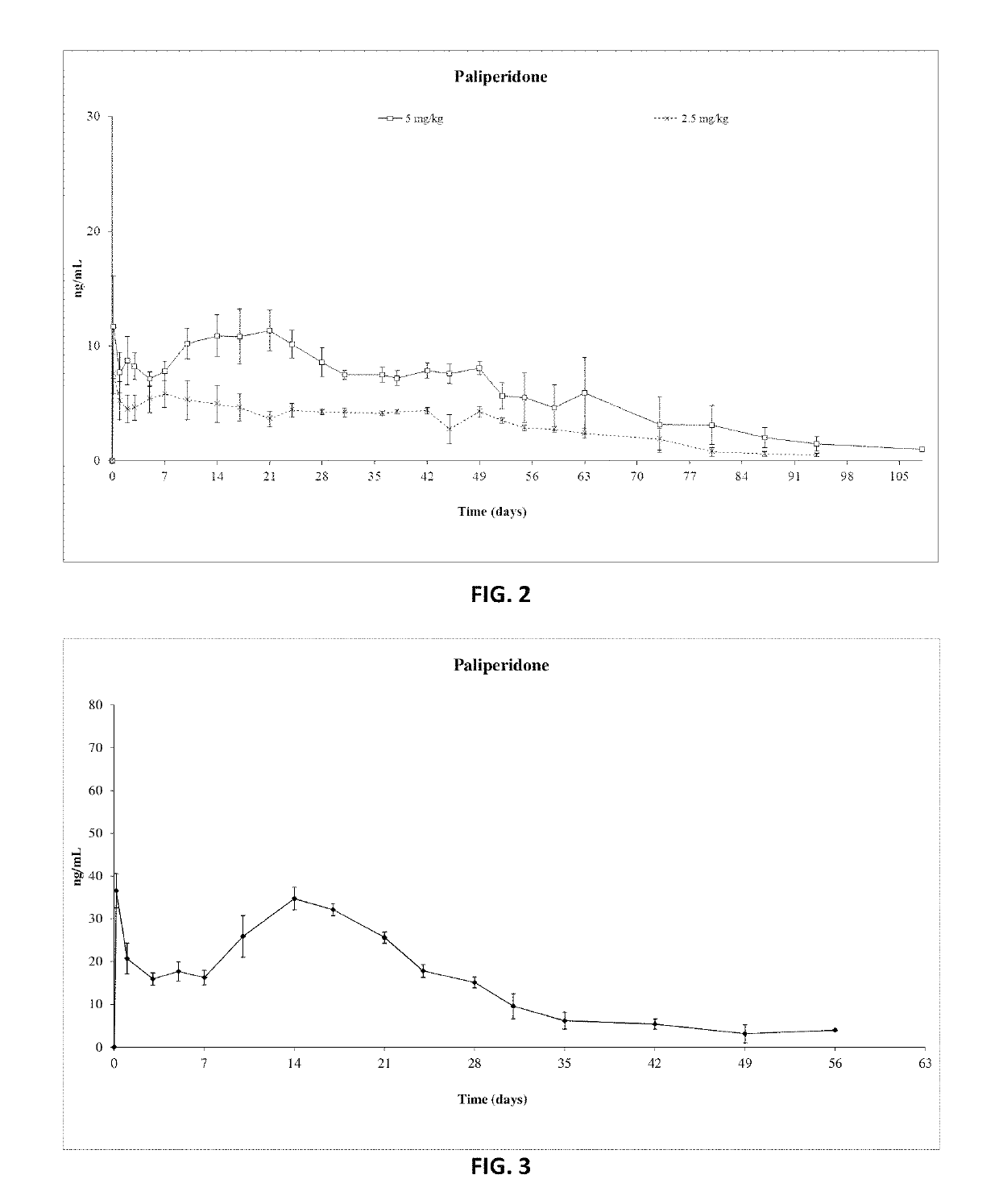Paliperidone implant formulation
a technology of paliperidone and formulation, which is applied in the directions of medical preparations, organic active ingredients, pharmaceutical non-active ingredients, etc., can solve the problems that the compositions already described in the state of the art do not meet the existing needs of paliperidone compositions, kits and treatments
- Summary
- Abstract
- Description
- Claims
- Application Information
AI Technical Summary
Benefits of technology
Problems solved by technology
Method used
Image
Examples
example 1
mulation with Resomer® 503
[0136]In the present example, the following formulation was prepared:
[0137]
IngredientAmount (mg)Female 2.25 mlLactic-co-glycolic acid copolymer 50syringe(N-capped) with 50% content of each of the two organic acid monomers and a molecular weight of 32.5 KDaPaliperidone25Male 2.25 ml Dimethyl sulfoxide117syringe
[0138]Paliperidone particle size was characterized by light scattering and provided the following distribution of particle size: d(0.1)=17.41 μm, d(0.5)=51.61 μm and d(0.9)=175.32 μm.
[0139]Polymer has been characterized for its molecular weight according to the following technique:
Equipment
[0140]GPC chromatograph with triple detector (laser diffraction, viscosimetry, refraction index)[0141]Viscotek® GPCmax VE 2001 GPC SOLVENT / SAMPLE MODULE[0142]Viscotek® TDA 305 TRIPLE DETECTOR ARRAY
Reagents[0143]Tetrahydrofurane (THF) grade GPC stabilized with butyl hydroxyl toluene (BHT) 250 ppm[0144]Polystyrene narrow standard (preferable about a molecular weight of...
example 2
mulation with Resomer® 504 Radiated to 16 KGy. 2 Doses
[0173]Preparation of sterile formulations to be used in vivo can require the use of procedures, such as irradiation, that have the potential to affect the polymer molecular structure. The example shows that the polymer molecular weight loss that occur upon polymer irradiation can be measured and controlled in order to achieve a sterile polymer with the desired characteristics in order to obtain adequate plasma levels profile of paliperidone.
[0174]In this example, a lactic-co-glycolic acid copolymer with 50% content of each of the two organic acid monomers and a molecular weight of 50 kDa was sterilized by beta irradiation at 16 kGy under controlled temperature and moisture conditions. The resultant polymer was characterized for its molecular weight according to the method described in example 1. Molecular weight after irradiation process was 40 KDa.
[0175]
IngredientAmount (mg)Female 2.25 ml Lactic-co-glycolic acid copolymer 100syr...
example 3
mulation with Lakeshore Biomaterials® 5050DLG 5E Radiated to 25 KGy
[0183]Preparation of sterile formulations to be used in vivo can require the use of procedures, such as irradiation, that have the potential to affect the polymer molecular structure. The example shows that the polymer molecular weight loss that occur upon polymer irradiation can be measured and controlled in order to achieve a sterile polymer with the desired characteristics in order to obtain adequate plasma levels profile of paliperidone.
[0184]In this example, a lactic-co-glycolic acid copolymer with 50% content of each of the two organic acid monomers and a molecular weight of 54 kDa was sterilized by beta irradiation at 25 kGy under controlled temperature and moisture conditions. The resultant polymer was characterized for its molecular weight according to the method described in example 1. Molecular weight after irradiation process was 42 KDa.
[0185]
IngredientAmount (mg)Female 2.25 ml Lactic-co-glycolic acid cop...
PUM
| Property | Measurement | Unit |
|---|---|---|
| particle size distribution | aaaaa | aaaaa |
| temperature | aaaaa | aaaaa |
| temperature | aaaaa | aaaaa |
Abstract
Description
Claims
Application Information
 Login to View More
Login to View More - R&D
- Intellectual Property
- Life Sciences
- Materials
- Tech Scout
- Unparalleled Data Quality
- Higher Quality Content
- 60% Fewer Hallucinations
Browse by: Latest US Patents, China's latest patents, Technical Efficacy Thesaurus, Application Domain, Technology Topic, Popular Technical Reports.
© 2025 PatSnap. All rights reserved.Legal|Privacy policy|Modern Slavery Act Transparency Statement|Sitemap|About US| Contact US: help@patsnap.com



